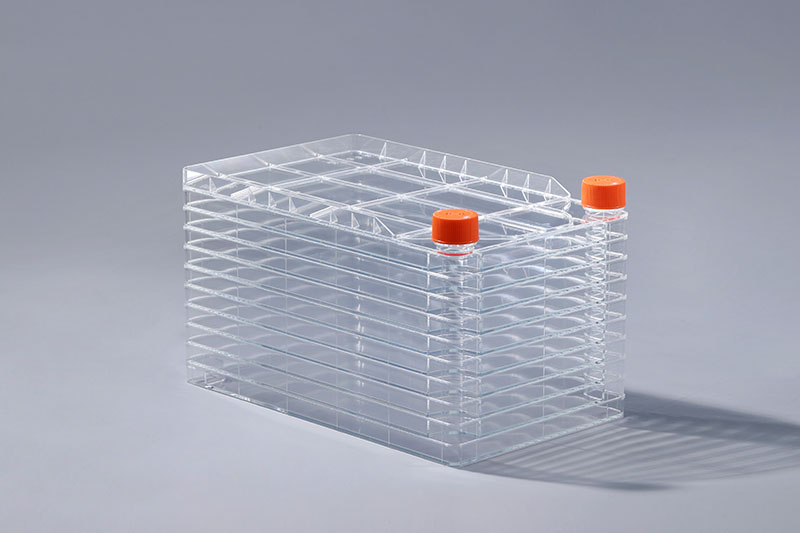عبارة عن مستنبت خلية متعدد الطبقات قابل للاستهلاك ، والذي يستخدم في الغالب في الإنتاج الضخم الصناعي والعمليات المختبرية وزراعة الخلايا على نطاق واسع ، وهو خيار مثالي للخلايا الملتصقة. عند اختيار هذا النوع من المواد الاستهلاكية ، سوف ننتبه إلى عامل رئيسي ، وهو معالجة السطح TC ، فلماذا يجب أن يخضع لهذه المعاملة الخاصة؟ يمكن تقسيم الخلايا إلى نوعين: ملتصقة الخلايا والخلايا المعلقة وفق طرق النمو المختلفة. لا تحتاج الخلايا المعلقة إلى أن تكون مثبتة بدعامة لتنمو ، ويمكن أن تنمو في حالة تعليق في وسط مستنبت. يجب أن يكون للخلايا الملتصقة سطح نمو يمكن أن تلتصق به لتنمو ، ويمكن فقط للواجهة الصلبة المحبة للماء أن تسمح للخلايا بالالتصاق. مواد خام البوليسترين الشفاف (PS). كمواد بوليمر ، تتمتع PS بقوة وليونة جيدة ، وليس لها سمية ، وقد أصبحت المادة المفضلة لمستهلكات زراعة الخلايا التي يمكن التخلص منها. ومع ذلك ، فإن سطح PS كاره للماء ، وهو في حد ذاته لا يؤدي إلى نمو الخلايا الملتصقة. من أجل تعزيز أداء التصاق الخلايا ، من الضروري الخضوع لمعالجة تعديل السطح وإدخال مجموعات محبة للماء للسماح للخلايا بالنمو بشكل أفضل. cell factory
باختصار ، الغرض من معالجة TC على سطح مصنع الخلية هو التكيف مع نمو الخلايا الملتصقة. لا تتطلب المواد الاستهلاكية المستخدمة في زراعة الخلايا المعلقة بالضرورة مثل هذه الأوعية المعالجة بشكل خاص ، ولكن المواد الاستهلاكية بعد معالجة السطح TC مناسبة أيضًا بشكل عام لاستنبات الخلايا المعلقة.
The cell factory is mainly used for the culture of adherent cells, which is processed by injection molding of transparent polystyrene (PS) raw materials. As a polymer material, PS has good strength and plasticity, and has no toxicity, and has become the preferred material for disposable cell culture consumables. However, the surface of PS is hydrophobic, which itself is not conducive to the growth of adherent cells. In order to enhance the adherence performance of cells, it is necessary to undergo surface modification treatment and introduce hydrophilic groups to allow cells to grow better.
In summary, the purpose of TC treatment on the cell factory surface is to adapt to the growth of adherent cells. The consumables used for suspension cell culture do not necessarily require such specially treated vessels, but the consumables after surface TC treatment are generally also suitable for the culture of suspension cells.
The FAI climbed 5.9 percent year-on-year in the first 11 months of 2018, quickening from the 5.7-percent growth in Jan-Oct, the National Bureau of Statistics (NBS) said Friday in an online statement.
The key indicator of investment, dubbed a major growth driver, hit the bottom in August and has since started to rebound steadily.
In the face of emerging economic challenges home and abroad, China has stepped up efforts to stabilize investment, in particular rolling out measures to motivate private investors and channel funds into infrastructure.
Friday's data showed private investment, accounting for more than 60 percent of the total FAI, expanded by a brisk 8.7 percent.
NBS spokesperson Mao Shengyong said funds into weak economic links registered rapid increases as investment in environmental protection and agriculture jumped 42 percent and 12.5 percent respectively, much faster than the average.
In breakdown, investment in high-tech and equipment manufacturing remained vigorous with 16.1-percent and 11.6-percent increases respectively in the first 11 months. Infrastructure investment gained 3.7 percent, staying flat. Investment in property development rose 9.7 percent, also unchanged.
 English
English



















































